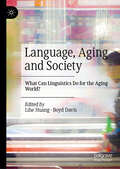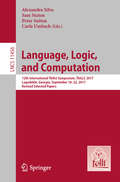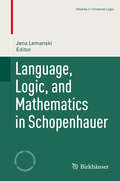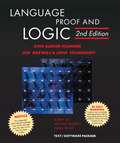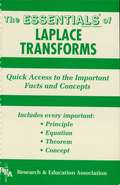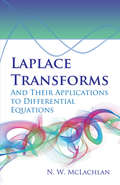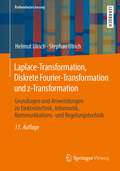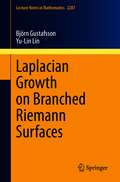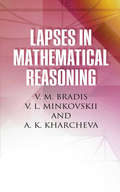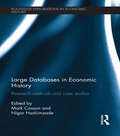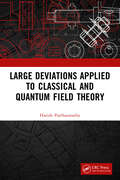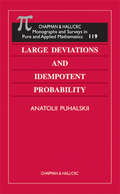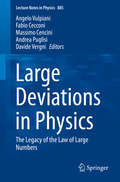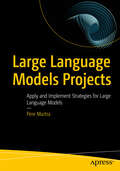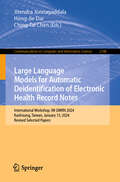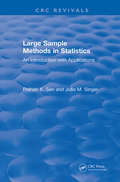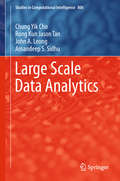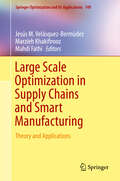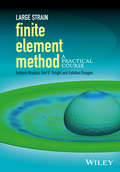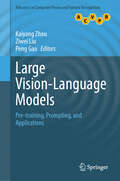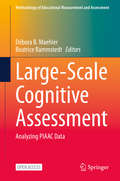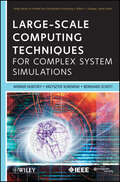- Table View
- List View
Language, Aging and Society: What Can Linguistics Do for the Aging World?
by Lihe Huang Boyd DavisThis book explores how studies of language and aging can be applied to build an aging-friendly society, drawing on the socio-pragmatic turn in language and aging to examine the perspectives of older adults experiencing aging through a linguistic lens. Research on the phenomenon and mechanisms of language in aging can provide older adults with language training, increase their active aging, and offer improved information communication channels for an aging society, which will bring a series of clinical and social benefits to handle problems in aging and language across the world. This book will be of interest to researchers in linguistics, sociology, gerontology and related fields.
Language, Logic, and Computation: 12th International Tbilisi Symposium, TbiLLC 2017, Lagodekhi, Georgia, September 18-22, 2017, Revised Selected Papers (Lecture Notes in Computer Science #11456)
by Peter Sutton Alexandra Silva Sam Staton Carla UmbachThis book constitutes the refereed proceedings of the 12th International Tbilisi Symposium on Logic, Language and Computation, TbiLLC 2017, held in Lagodekhi, Georgia, in September 2017.The volume contains 17 full revised papers presented at the conference from 22 submissions. The aim of this conference series is to bring together researchers from a wide variety of fields in Natural language syntax, Linguistic typology, Language evolution, Logics for artificial intelligence and much more.
Language, Logic, and Mathematics in Schopenhauer (Studies in Universal Logic)
by Jens LemanskiThe chapters in this timely volume aim to answer the growing interest in Arthur Schopenhauer’s logic, mathematics, and philosophy of language by comprehensively exploring his work on mathematical evidence, logic diagrams, and problems of semantics. Thus, this work addresses the lack of research on these subjects in the context of Schopenhauer’s oeuvre by exposing their links to modern research areas, such as the “proof without words” movement, analytic philosophy and diagrammatic reasoning, demonstrating its continued relevance to current discourse on logic. Beginning with Schopenhauer’s philosophy of language, the chapters examine the individual aspects of his semantics, semiotics, translation theory, language criticism, and communication theory. Additionally, Schopenhauer’s anticipation of modern contextualism is analyzed. The second section then addresses his logic, examining proof theory, metalogic, system of natural deduction, conversion theory, logical geometry, and the history of logic. Special focus is given to the role of the Euler diagrams used frequently in his lectures and their significance to broader context of his logic. In the final section, chapters discuss Schopenhauer’s philosophy of mathematics while synthesizing all topics from the previous sections, emphasizing the relationship between intuition and concept. Aimed at a variety of academics, including researchers of Schopenhauer, philosophers, historians, logicians, mathematicians, and linguists, this title serves as a unique and vital resource for those interested in expanding their knowledge of Schopenhauer’s work as it relates to modern mathematical and logical study.
Language, Proof and Logic 2nd Edition
by David Barker-Plummer Jon Barwise John EtchemendyThis book covers first-order language in a method appropriate for first and second courses in logic. It is designed to be used by undergraduates in philosophy, computer science, mathematics, and linguistics. Introductory material is presented in a systematic and accessible fashion. Advanced chapters include proofs of soundness and completeness for propositional and predicate logic, as well as an accessible sketch of Godel's first incompleteness theorem. The book is appropriate for a wide range of courses, from first logic courses for undergraduates (philosophy, mathematics, and computer science) to a first graduate logic course.
Language, Space and Mind
by Paul ChiltonThe idea that spatial cognition provides the foundation of linguistic meanings, even highly abstract meanings, has been put forward by a number of linguists in recent years. This book takes this proposal into new dimensions and develops a theoretical framework based on simple geometric principles. All speakers are conceptualisers who have a point of view both in a literal and in an abstract sense, choosing their perspective in space, time and the real world. The book examines the conceptualising properties of verbs, including tense, aspect, modality and transitivity, as well as the conceptual workings of grammatical constructions associated with counterfactuality, other minds and the expression of moral force. It makes links to the cognitive sciences throughout and concludes with a discussion of the relationship between language, brain and mind.
Laplace Transforms Essentials
by Morteza Shafii-MousaviREA's Essentials provide quick and easy access to critical information in a variety of different fields, ranging from the most basic to the most advanced. As its name implies, these concise, comprehensive study guides summarize the essentials of the field covered. Essentials are helpful when preparing for exams, doing homework and will remain a lasting reference source for students, teachers, and professionals. Laplace Transforms includes the Laplace transform, the inverse Laplace transform, special functions and properties, applications to ordinary linear differential equations, Fourier transforms, applications to integral and difference equations, applications to boundary value problems, and tables.
Laplace Transforms and Their Applications to Differential Equations
by N. W. MclachlanThis introduction to modern operational calculus offers a classic exposition of Laplace transform theory and its application to the solution of ordinary and partial differential equations. The treatment is addressed to graduate students in engineering, physics, and applied mathematics and may be used as a primary text or supplementary reading.Chief topics include the theorems or rules of the operational calculus, evaluation of integrals and establishment of mathematical relationships, derivation of Laplace transforms of various functions, the Laplace transform for a finite interval, and other subjects. Many problems and illustrative examples appear throughout the book, which is further augmented by helpful Appendixes.
Laplace-Transformation, Diskrete Fourier-Transformation und z-Transformation: Grundlagen und Anwendungen zu Elektrotechnik, Informatik, Kommunikations- und Regelungstechnik
by Helmut Ulrich Stephan UlrichDieses Buch ist eine leicht verständliche Einführung in die Theorie und praktische Handhabung der Laplace-, Fourier- und z-Transformation, die in vielen Fachgebieten wie der Elektrotechnik , Informations- und Kommunikationstechnik, Mechatronik, Regelungstechnik etc. eine wichtige Rolle spielen. Zahlreiche Beispiele und Anwendungen zeigen den richtigen Umgang mit den Transformationen. Die Erläuterungen werden vielfach durch graphische Darstellungen veranschaulicht. Das Ziel des Buches ist es, eigene Problemstellungen mit den gezeigten Methoden erfolgreich angehen zu können. Die didaktische Aufbereitung des Lehrstoffes im Buch sichert einen nachhaltigen Lernerfolg .
Laplacian Growth on Branched Riemann Surfaces (Lecture Notes in Mathematics #2287)
by Björn Gustafsson Yu-Lin LinThis book studies solutions of the Polubarinova–Galin and Löwner–Kufarev equations, which describe the evolution of a viscous fluid (Hele-Shaw) blob, after the time when these solutions have lost their physical meaning due to loss of univalence of the mapping function involved. When the mapping function is no longer locally univalent interesting phase transitions take place, leading to structural changes in the data of the solution, for example new zeros and poles in the case of rational maps. This topic intersects with several areas, including mathematical physics, potential theory and complex analysis. The text will be valuable to researchers and doctoral students interested in fluid dynamics, integrable systems, and conformal field theory.
Lapses in Mathematical Reasoning (Dover Books on Mathematics)
by A. K. Kharcheva L. Minkovskii V. M. BradisDesigned as a method for teaching correct mathematical thinking to high school students, this book contains a brilliantly constructed series of what the authors call "lapses," erroneous statements that are part of a larger mathematical argument. These lapses lead to sophism or mathematical absurdities. The ingenious idea behind this technique is to lead the student deliberately toward a clearly false conclusion. The teacher and student then go back and analyze the lapse as a way to correct the problem.The authors begin by focusing on exercises in refuting erroneous mathematical arguments and their classification. The remaining chapters discuss examples of false arguments in arithmetic, algebra, geometry, trigonometry, and approximate computations. Ideally, students will come to the correct insights and conclusions on their own; however, each argument is followed by a detailed analysis of the false reasoning. Stimulating and unique, this book is an intriguing and enjoyable way to teach students critical mathematical reasoning skills.
Large Databases in Economic History: Research Methods and Case Studies (Routledge Explorations in Economic History #67)
by Mark Casson Nigar Hashimzade‘Big data’ is now readily available to economic historians, thanks to the digitisation of primary sources, collaborative research linking different data sets, and the publication of databases on the internet. Key economic indicators, such as the consumer price index, can be tracked over long periods, and qualitative information, such as land use, can be converted to a quantitative form. In order to fully exploit these innovations it is necessary to use sophisticated statistical techniques to reveal the patterns hidden in datasets, and this book shows how this can be done. A distinguished group of economic historians have teamed up with younger researchers to pilot the application of new techniques to ‘big data’. Topics addressed in this volume include prices and the standard of living, money supply, credit markets, land values and land use, transport, technological innovation, and business networks. The research spans the medieval, early modern and modern periods. Research methods include simultaneous equation systems, stochastic trends and discrete choice modelling. This book is essential reading for doctoral and post-doctoral researchers in business, economic and social history. The case studies will also appeal to historical geographers and applied econometricians.
Large Deviations Applied to Classical and Quantum Field Theory
by Harish ParthasarathyThis book deals with a variety of problems in Physics and Engineering where the large deviation principle of probability finds application. Large deviations is a branch of probability theory dealing with approximate computation of the probabilities of rare events. It contains applications of the LDP to pattern recognition problems like analysis of the performance of the EM algorithm for optimal parameter estimation in the presence of weak noise, analysis and control of non-Abelian gauge fields in the presence of noise, and quantum gravity wherein we are concerned with perturbation to the quadratic component of the Einstein-Hilbert Hamiltonian caused by higher order nonlinear terms in the position fields and their effect on the Gibbs statistics and consequently quantum probabilities of events computed using the quantum Gibbs state. The reader will also find in this book applications of LDP to quantum filtering theory as developed by Belavkin based on the celebrated Hudson-Parthasarathy quantum stochastic calculus. Print edition not for sale in South Asia (India, Sri Lanka, Nepal, Bangladesh, Pakistan and Bhutan).
Large Deviations and Idempotent Probability
by Anatolii PuhalskiiIn the view of many probabilists, author Anatolii Puhalskii's research results stand among the most significant achievements in the modern theory of large deviations. In fact, his work marked a turning point in the depth of our understanding of the connections between the large deviation principle (LDP) and well-known methods for establishing weak
Large Deviations in Physics
by Angelo Vulpiani Andrea Puglisi Fabio Cecconi Massimo Cencini Davide VergniThis book reviews the basic ideas of the Law of Large Numbers with its consequences to the deterministic world and the issue of ergodicity. Applications of Large Deviations and their outcomes to Physics are surveyed. The book covers topics encompassing ergodicity and its breaking and the modern applications of Large deviations to equilibrium and non-equilibrium statistical physics, disordered and chaotic systems, and turbulence.
Large Language Models (Methods in Molecular Biology #2941)
by Dukka B. KcThis book presents a comprehensive collection of methods, resources, and studies that use large language models (LLMs) in the field of protein bioinformatics. Reflecting the swift pace of LLM development today, the volume delves into numerous LLM-based tools to investigate proteins science, from protein language models to the prediction of protein-ligand binding sites. Written for the highly successful Methods in Molecular Biology series, chapters include the kind of detailed implementation advice to ensure success in future research. Authoritative and practical, Large Language Models (LLMs) in Protein Bioinformatics serves as an ideal guide for scientists seeking to tap into the potential of artificial intelligence in this vital area of biological study.
Large Language Models Ops for Finance: A Practical Guide to Infrastructure, Implementation, and Innovation
by Brindha Priyadarshini JeyaramanExplore emerging technologies and the evolving role of AI in finance. Geared toward finance professionals, this book will equip you with the knowledge and tools to harness the power of Large Language Models (LLMs), ensuring you stay ahead in an increasingly AI-driven industry. Highlighting the benefits and challenges of LLMs in financial contexts, the book starts with the necessary infrastructure setup, covering both hardware and software requirements. It offers a balanced discussion on cloud versus on-premises solutions, enabling you to make informed decisions based on their specific needs. Training and fine-tuning LLMs are critical components of effective deployment, and this book offers best practices, from data preparation to advanced fine-tuning techniques. It also delves into deployment strategies, with practical advice on building deployment pipelines, monitoring performance, and optimizing operations. Ensuring data privacy and security is paramount in finance, so you&’ll take a close look at maintaining compliance with regulations while safeguarding sensitive information. You&’ll also examine the integration of LLMs into existing financial systems, with real-world case studies and strategies for API development and real-time data processing. Monitoring and maintenance are crucial for long-term success, and the book outlines how to manage performance metrics, handle model drift, and ensure regular updates. Large Language Models Ops for Finance is your essential guide to discovering the transformative potential of LLMs in the finance industry. What You Will Learn ● Review LLMs and their applications in finance. ● <span lang="EN-IN" style="font-size: 12.0pt; font-family: 'Times New
Large Language Models Projects: Apply and Implement Strategies for Large Language Models
by Pere MartraThis book offers you a hands-on experience using models from OpenAI and the Hugging Face library. You will use various tools and work on small projects, gradually applying the new knowledge you gain. The book is divided into three parts. Part one covers techniques and libraries. Here, you'll explore different techniques through small examples, preparing to build projects in the next section. You'll learn to use common libraries in the world of Large Language Models. Topics and technologies covered include chatbots, code generation, OpenAI API, Hugging Face, vector databases, LangChain, fine tuning, PEFT fine tuning, soft prompt tuning, LoRA, QLoRA, evaluating models, and Direct Preference Optimization. Part two focuses on projects. You'll create projects, understanding design decisions. Each project may have more than one possible implementation, as there is often not just one good solution. You'll also explore LLMOps-related topics. Part three delves into enterprise solutions. Large Language Models are not a standalone solution; in large corporate environments, they are one piece of the puzzle. You'll explore how to structure solutions capable of transforming organizations with thousands of employees, highlighting the main role that Large Language Models play in these new solutions. This book equips you to confidently navigate and implement Large Language Models, empowering you to tackle diverse challenges in the evolving landscape of language processing. What You Will Learn Gain practical experience by working with models from OpenAI and the Hugging Face library Use essential libraries relevant to Large Language Models, covering topics such as Chatbots, Code Generation, OpenAI API, Hugging Face, and Vector databases Create and implement projects using LLM while understanding the design decisions involved Understand the role of Large Language Models in larger corporate settings Who This Book Is For Data analysts, data science, Python developers, and software professionals interested in learning the foundations of NLP, LLMs, and the processes of building modern LLM applications for various tasks
Large Language Models for Automatic Deidentification of Electronic Health Record Notes: International Workshop, IW-DMRN 2024, Kaohsiung, Taiwan, January 15, 2024, Revised Selected Papers (Communications in Computer and Information Science #2148)
by Jitendra Jonnagaddala Hong-Jie Dai Ching-Tai ChenThis volume constitutes the refereed proceedings of the International Workshop on Deidentification of Electronic Health Record Notes, IW-DMRN 2024, held on January 15, 2024, in Kaohsiung, Taiwan. The 15 full papers were carefully reviewed and selected from 30 submissions. The conference focuses on medical data analysis, enhancing medication safety, and optimizing medical care efficiency.
Large Sample Methods in Statistics: An Introduction with Applications (CRC Press Revivals)
by Pranab K. Sen Julio M. SingerThis text bridges the gap between sound theoretcial developments and practical, fruitful methodology by providing solid justification for standard symptotic statistical methods. It contains a unified survey of standard large sample theory and provides access to more complex statistical models that arise in diverse practical applications.
Large Scale Data Analytics (Studies in Computational Intelligence #806)
by Amandeep S. Sidhu John A. Leong Rong Kun Tan Chung Yik ChoThis book presents a language integrated query framework for big data. The continuous, rapid growth of data information to volumes of up to terabytes (1,024 gigabytes) or petabytes (1,048,576 gigabytes) means that the need for a system to manage and query information from large scale data sources is becoming more urgent. Currently available frameworks and methodologies are limited in terms of efficiency and querying compatibility between data sources due to the differences in information storage structures. For this research, the authors designed and programmed a framework based on the fundamentals of language integrated query to query existing data sources without the process of data restructuring. A web portal for the framework was also built to enable users to query protein data from the Protein Data Bank (PDB) and implement it on Microsoft Azure, a cloud computing environment known for its reliability, vast computing resources and cost-effectiveness.
Large Scale Optimization in Supply Chains and Smart Manufacturing: Theory and Applications (Springer Optimization and Its Applications #149)
by Jesús M. Velásquez-Bermúdez Marzieh Khakifirooz Mahdi FathiIn this book, theory of large scale optimization is introduced with case studies of real-world problems and applications of structured mathematical modeling. The large scale optimization methods are represented by various theories such as Benders’ decomposition, logic-based Benders’ decomposition, Lagrangian relaxation, Dantzig –Wolfe decomposition, multi-tree decomposition, Van Roy’ cross decomposition and parallel decomposition for mathematical programs such as mixed integer nonlinear programming and stochastic programming. Case studies of large scale optimization in supply chain management, smart manufacturing, and Industry 4.0 are investigated with efficient implementation for real-time solutions. The features of case studies cover a wide range of fields including the Internet of things, advanced transportation systems, energy management, supply chain networks, service systems, operations management, risk management, and financial and sales management. Instructors, graduate students, researchers, and practitioners, would benefit from this book finding the applicability of large scale optimization in asynchronous parallel optimization, real-time distributed network, and optimizing the knowledge-based expert system for convex and non-convex problems.
Large Strain Finite Element Method
by Earl E. Knight Esteban Rougier Antonio MunjizaAn introductory approach to the subject of large strains and large displacements in finite elements.Large Strain Finite Element Method: A Practical Course, takes an introductory approach to the subject of large strains and large displacements in finite elements and starts from the basic concepts of finite strain deformability, including finite rotations and finite displacements. The necessary elements of vector analysis and tensorial calculus on the lines of modern understanding of the concept of tensor will also be introduced.This book explains how tensors and vectors can be described using matrices and also introduces different stress and strain tensors. Building on these, step by step finite element techniques for both hyper and hypo-elastic approach will be considered.Material models including isotropic, unisotropic, plastic and viscoplastic materials will be independently discussed to facilitate clarity and ease of learning. Elements of transient dynamics will also be covered and key explicit and iterative solvers including the direct numerical integration, relaxation techniques and conjugate gradient method will also be explored.This book contains a large number of easy to follow illustrations, examples and source code details that facilitate both reading and understanding. Takes an introductory approach to the subject of large strains and large displacements in finite elements. No prior knowledge of the subject is required.Discusses computational methods and algorithms to tackle large strains and teaches the basic knowledge required to be able to critically gauge the results of computational models.Contains a large number of easy to follow illustrations, examples and source code details.Accompanied by a website hosting code examples.
Large Vision-Language Models: Pre-training, Prompting, and Applications (Advances in Computer Vision and Pattern Recognition)
by Kaiyang Zhou Ziwei Liu Peng GaoThe rapid progress in the field of large multimodal foundation models, especially vision-language models, has dramatically transformed the landscape of machine learning, computer vision, and natural language processing. These powerful models, trained on vast amounts of multimodal data mixed with images and text, have demonstrated remarkable capabilities in tasks ranging from image classification and object detection to visual content generation and question answering. This book provides a comprehensive and up-to-date exploration of large vision-language models, covering the key aspects of their pre-training, prompting techniques, and diverse real-world computer vision applications. It is an essential resource for researchers, practitioners, and students in the fields of computer vision, natural language processing, and artificial intelligence. Large Vision-Language Models begins by exploring the fundamentals of large vision-language models, covering architectural designs, training techniques, and dataset construction methods. It then examines prompting strategies and other adaptation methods, demonstrating how these models can be effectively fine-tuned to address a wide range of downstream tasks. The final section focuses on the application of vision-language models across various domains, including open-vocabulary object detection, 3D point cloud processing, and text-driven visual content generation and manipulation. Beyond the technical foundations, the book explores the wide-ranging applications of vision-language models (VLMs), from enhancing image recognition systems to enabling sophisticated visual content generation and facilitating more natural human-machine interactions. It also addresses key challenges in the field, such as feature alignment, scalability, data requirements, and evaluation metrics. By providing a comprehensive roadmap for both newcomers and experts, this book serves as a valuable resource for understanding the current landscape, limitations, and future directions of VLMs, ultimately contributing to the advancement of artificial intelligence.
Large-Scale Cognitive Assessment: Analyzing PIAAC Data (Methodology of Educational Measurement and Assessment)
by Débora B. Maehler Beatrice RammstedtThis open access methodological book summarises existing analysing techniques using data from PIAAC, a study initiated by the OECD that assesses key cognitive and occupational skills of the adult population in more than 40 countries. The approximately 65 PIAAC datasets that has been published worldwide to date has been widely received and used by an interdisciplinary research community. Due to the complex structure of the data, analyses with PIAAC datasets are very challenging. To ensure the quality and significance of these data analyses, it is necessary to instruct users in the correct handling of the data. This methodological book provides a standardised approach to successfully implementing these data analyses. It contains examples of and tools for the analysis of the PIAAC data using different statistical approaches and software, and it offers perspectives from various disciplines. The contributing authors have hands-on experience of using PIAAC data, and/or they have conducted data analysis workshops with these data.
Large-Scale Computing Techniques for Complex System Simulations
by Werner Dubitzky Krzysztof Kurowski Bernard SchottComplex systems modeling and simulation approaches are being adopted in a growing number of sectors, including finance, economics, biology, astronomy, and many more. Technologies ranging from distributed computing to specialized hardware are explored and developed to address the computational requirements arising in complex systems simulations. The aim of this book is to present a representative overview of contemporary large-scale computing technologies in the context of complex systems simulations applications. The intention is to identify new research directions in this field and to provide a communications platform facilitating an exchange of concepts, ideas and needs between the scientists and technologist and complex system modelers. On the application side, the book focuses on modeling and simulation of natural and man-made complex systems. On the computing technology side, emphasis is placed on the distributed computing approaches, but supercomputing and other novel technologies are also considered.
